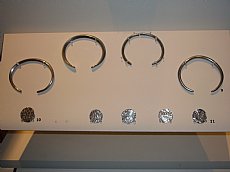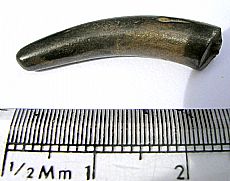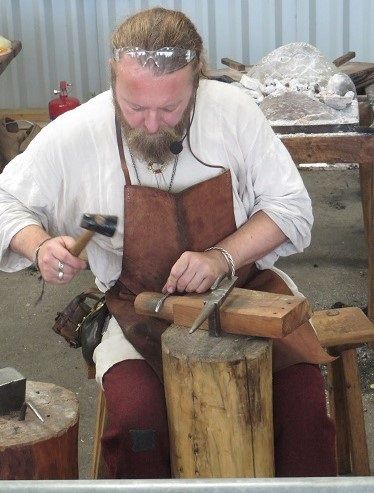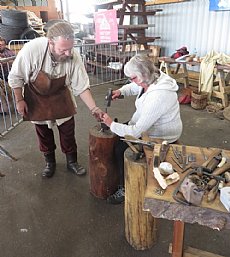Viking Ring-Money workshop
Posted by Susan Kruse - 14:24 on 26 August 2018
 In August Jim Glazzard from Asgard Crafts returned, this time to show us Viking silversmithing skills and in particular how to make a distinctive Scottish armring often termed ‘ring-money’.
In August Jim Glazzard from Asgard Crafts returned, this time to show us Viking silversmithing skills and in particular how to make a distinctive Scottish armring often termed ‘ring-money’.
In the Viking world, silver was the main precious metal. Craftsmen made beautiful jewellery, and Jim described some of the techniques used as he worked. But silver was also used as money, with objects, coins, fragments of objects (hacksilver) and casting scraps weighed on portable balances. In the Viking world which stretched along the Baltic and into Europe coins were only valued for their weight, not having any guaranteed buying power. This provided consistency across the vast areas the Vikings travelled and traded, but it also led to complications when different weight systems were used. Sagas written in Iceland which date several hundred years later describe people using an armring to pay for expensive items, or even chopping it to roughly the required weight.
In Scotland a simple type of armring is found in hoards from the Viking period, as complete examples and fragments. Some have small nicks, presumably made to test the purity of the silver. Archaeologists have termed these bracelets ‘ring-money.’ They could have been used as jewellery, but if need arose, could be used as money.
In 1889 a hoard of four armrings together with some coins from the Frankish and Anglo-Saxon empire was found in the wall at Tarbat church, Portmahomack by a gravedigger (above left). The coins allow the hoard to be dated to around AD 1000, showing that this collection of wealth was deposited not during the first Viking raids in the 800s, but several centuries later. How the coins travelled to Scotland, why the hoard was put in a churchwall, who was its owner and why he didn’t return for it are all interesting questions! Other examples of ring money in the Highlands are from Kirk o’Banks in Caithness and a small fragment found recently in Dorno ch (above right).
ch (above right).
Jim set about to make a silver copy of one of the armrings found in the Tarbat hoard using replica equipment. He has built a small portable forge with bellows, in part modelled after a stave church carving from Norway. His tools were modelled on an amazing find from Gotland, where a large number of tools as well as the wooden chest survived.
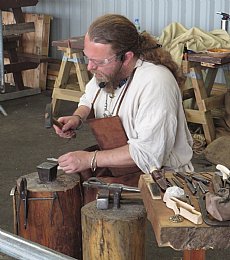 Jim brought with him silver ingots he had previously cast, melting silver in a crucible and pouring it into a clay mould. The next step was to hammer the ingot into a long rod for twisting (left). However, as silver is hammered, it gets harder, so the smith has to periodically soften the work in progress in a process called annealing. This is where the real experimentation took part in our workshop since the way a Viking smith
Jim brought with him silver ingots he had previously cast, melting silver in a crucible and pouring it into a clay mould. The next step was to hammer the ingot into a long rod for twisting (left). However, as silver is hammered, it gets harder, so the smith has to periodically soften the work in progress in a process called annealing. This is where the real experimentation took part in our workshop since the way a Viking smith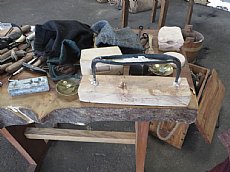 would have done this is not clear. A 12th century European treatise by Theophilus describes a tallow-burning apparatus which Jim has reconstructed (right), but it is uncertain how temperatures could be hot enough in this. So Jim tried to anneal the ingot in the forge (above right). The first time the ingot melted. The second time a better result was obtained, although there was still some cracking, perhaps from flaws in the original ingot, perhaps from the annealing. Jim hopes to explore issues of annealing further – watch this space.
would have done this is not clear. A 12th century European treatise by Theophilus describes a tallow-burning apparatus which Jim has reconstructed (right), but it is uncertain how temperatures could be hot enough in this. So Jim tried to anneal the ingot in the forge (above right). The first time the ingot melted. The second time a better result was obtained, although there was still some cracking, perhaps from flaws in the original ingot, perhaps from the annealing. Jim hopes to explore issues of annealing further – watch this space.
Once a rod had been produced, it would have been been bent round to shape. Some ring-money (and many other Viking silver objects) were decorated with metal punches to produce designs. Jim showed how this would have been done using pewter hammered rods he had prepared. First any decoration was made using punches, and there was a chance to have a go at this (above left). Once the decoration was made, Jim switched to a mallet made of horn to hammer the rod to the desired shape (above right). This allowed enough force to bend the rod, without obliterating the decoration.
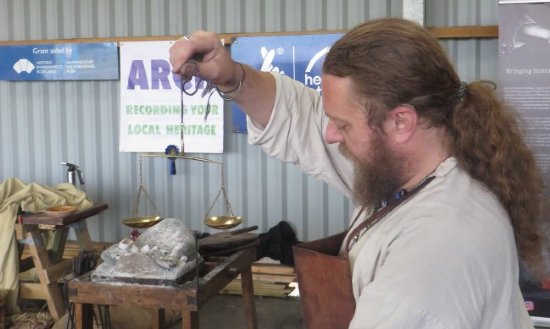
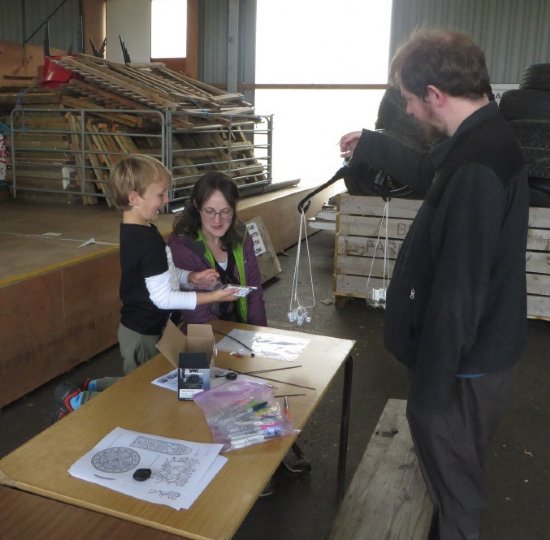
While Jim was working he also discussed other types of jewellery the Vikings made, and he had brought a number of replicas for people to look at (and buy). He also explained the economic system this silver circulated in, showing replicas of some of the coins from different nations, and describing the hacksilver – bits and pieces of any silver – which would have been used when weighing amounts during purchases. Jim had made a replica portable balance of the sort found in some Scandinavian pagan graves, and which would have been used whenever silver needed to be weighed in exchanges. Our children’s activities table also had a portable balance to try out (of different design), as well as colouring and runic worksheets.
As in so many of the workshops, we were again left with appreciation at the skills of the ancient craftspeople – as well as of the beautiful jewellery these smiths created.
Jim has made pewter replicas of a plain and decorated armrings and an Arabic coin for the loans box.


Other Resources
Books
Most books on the Vikings mention their metalworking skills.
Arwidsson, Greta and Berg, Gosta 2000. The Mästermyr Find: A Viking Age Tool Chest from Gotland. Publication of a well preserved Viking Age tool set – a wonderful find and essential for experimental archaeology!
Graham-Campbell, James 2006. The Viking-age Gold and Silver of Scotland, AD 850-1100. The definitive guide, but unfortunately out of print.
Graham-Campbell, James and Batey, Colleen 2003. Vikings in Scotland.
Hawthorne, J. G. and C. S. Smith 1963, reprinted 1979. Theophilus: On Divers Arts. Recommended by Jim for insights into what an early 12th medieval European craftsmen knew about metalworking.
Images Online
Try also the NMS website and search for ring money
Storr Rock, Skye hacksilver and coin hoard
Videos
Hand Crafting Viking Jewellery: Making an Arm Ring from Birka
Jim Glazzard making an arming
3:47
Hand Crafting Viking Jewellery: The Twisted Silver Neck Ring
Jim Glazzard making a twisted neckring
3:36
Hand Crafting Viking Jewellery : The Huxley Hoard
Jim Glazzard making replicas from the Huxley Hoard
3:11
2009 The silversmith at Foteviken
Silversmith working in the Viking Reserve at the Museum of Foteviken in Sweden
7:43
Websites
There are plenty of websites to look at, including:
Experimental bronze and silver working from Sweden
Jim Glazzard’s Asgard blog and website, which also has replica objects for sale.
The Experimental Archaeology: Learning about technologies in the past project has been funded by Historic Environment Scotland and the Heritage Lottery Fund.
Add your comment below
- Recent Blog Articles
- Learning Resources
- Crafting Day October 2018
- Medieval Coinage Workshop
- Viking Ring-Money workshop
- Thomas Telford Workshop
- Monthly Blog Archive
- June 2018
- May 2018
- April 2018
- March 2018
- February 2018
- January 2018
- December 2017
- November 2017

